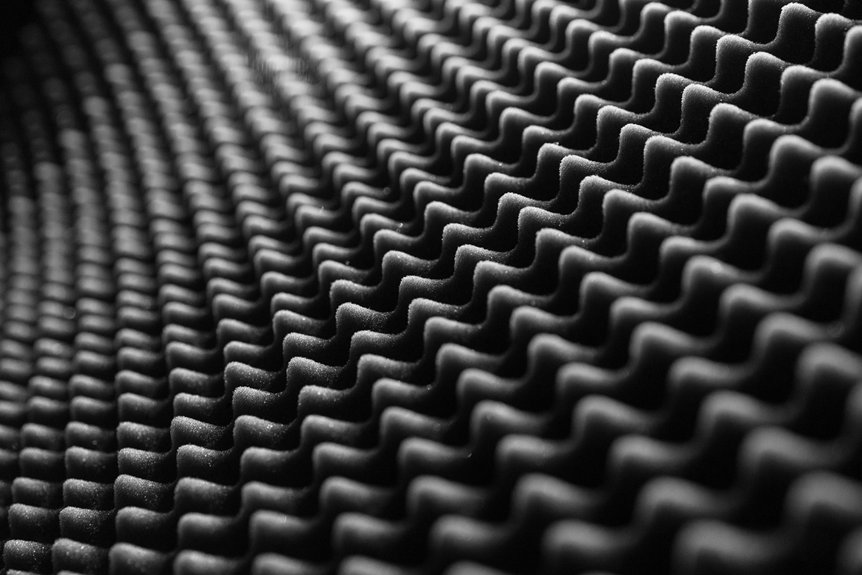Sound proofing foam is specifically designed to enhance indoor acoustics by absorbing sound reflections and minimising echo. It is available in various shapes, including egg crate, wedge, pyramid, and bass traps, each tailored for distinct environments.
While this foam effectively manages internal noise and reverberation, it does not block external sounds. The effectiveness of sound proofing foam can be significantly improved by proper placement and by combining it with other soundproofing techniques.
Exploring this topic further will provide insights into how to select and utilise foam for achieving optimal sound quality in your room.
Types and Shapes of Acoustic Foam
Different types and shapes of acoustic foam are designed to effectively absorb or redirect sound waves in various environments. Egg crate foam features a textured surface that resembles an egg carton, making it particularly effective for mid to high frequencies. Wedge foam, characterised by its triangular shapes, absorbs a broad spectrum of sounds, which is especially beneficial in compact spaces. Pyramid foam, with its pyramid-shaped protrusions, manages mid to high frequencies but offers slightly less absorption compared to wedge foam. Grid foam includes raised lines that aid in redirecting sound while also enhancing aesthetic appeal, often utilised in smaller areas. Bass traps are thicker panels intended for placement in room corners, specifically targeting low-frequency sounds. Each shape of acoustic foam offers distinct advantages, assisting in the creation of optimal sound environments by concentrating on specific frequencies and catering to aesthetic preferences. Additionally, proper placement of these panels is crucial to maximize their effectiveness in sound absorption and room acoustics.
Choosing the Right Foam for Different Environments
Choosing the right foam is crucial and depends significantly on the specific environment and its acoustic requirements.
For home studios, foam that effectively balances mid and high frequencies is ideal, with high noise reduction coefficients for optimal absorption. Incorporating diffusers can also help scatter sound evenly across the space, while bass traps are essential for managing low-frequency challenges. Material quality significantly impacts acoustic performance, making it essential to select high-quality foam to ensure long-term effectiveness.
In home cinemas, utilising high NRC foam is beneficial for reducing echoes and enhancing dialogue clarity, along with the addition of bass traps to control lower frequencies.
Offices and commercial spaces can greatly benefit from thicker foam panels, especially in open-plan layouts, as they help minimise noise transfer while also ensuring that the design complements the decor.
Control rooms necessitate uniform acoustic treatment, often employing thicker foam and diffusers to maintain some natural room sound while achieving a balanced audio environment.
Enhancing Room Acoustics With Effective Soundproofing Solutions
Good room acoustics are vital for establishing a clear and comfortable listening environment, whether for recording, enjoying films, or engaging in conversation.
Acoustic foam significantly enhances sound quality by reducing echo and reverberation through the absorption of sound reflections. Its soft, porous surface converts sound energy into heat, which effectively lowers reverberation time and improves speech clarity. Soundproofing foam does not block external noise, but it plays a crucial role in internal acoustic treatment.
It is important to understand that while acoustic foam doesn’t block external noise, it excels in managing internal sound reflections. The varied textures of its bumpy and flat surfaces facilitate easy attachment to walls and ceilings, aiding in the dispersion of sound waves.
Thicker acoustic foam is particularly effective at absorbing lower frequencies, whereas thinner foam is designed to target higher and mid-range frequencies.
While foam improves the internal sound quality of a space, the most effective approach to soundproofing combines it with additional methods, such as mass-loaded vinyl or enhanced drywall solutions. This combination provides a more comprehensive strategy for controlling noise transmission and achieving an optimal acoustic environment.
Conclusion
Selecting the appropriate soundproofing foam is crucial for optimising your environment and catering to specific needs. Various types and shapes of foam provide distinct advantages for managing noise and enhancing acoustics.
The correct placement and choice of foam can significantly elevate sound quality in any space. By comprehending these options, users can make well-informed decisions, ensuring effective noise reduction. Ultimately, soundproofing foam presents a practical and cost-effective solution for achieving improved room acoustics, whether for work, recording, or leisure activities.
Investing in soundproofing foam not only helps in minimising unwanted noise but also contributes to a more pleasant and focused atmosphere, making it an essential consideration for anyone looking to refine their acoustic environment.

